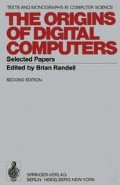Abstract
The earliest known electronic digital circuit, a “trigger relay”, which involved a pair of valves in a circuit with two stable states and was an early form of flip-flop, was described by Eccles and Jordan in 1919. (An unsubstantiated claim [1] has however been made that J. W. Bryce of IBM investigated the application of electronics to business machines in 1915.) The next development that we know of was the use by Wynn-Williams at the Cavendish Laboratory, Cambridge, of thyratrons in counting circuits including, in 1932, a “scale-of-two” (binary) counter [2]. By the end of the decade quite a few papers had been published on electronic counters intended for counting impulses from Geiger-Müller tubes used in nuclear physics experiments.
Access this chapter
Tax calculation will be finalised at checkout
Purchases are for personal use only
Preview
Unable to display preview. Download preview PDF.
Notes
The claim appears in “New Methods for Knowing” (Anon 1960b).
Wynn-Williams (1931, 1932).
Phillips (1962, 1965a).
Phillips did file two patent applications relating to a calculating apparatus on 24th December 1935. However no patents were ever granted and there is no record of the contents of the original applications.
Kern (1968), Snedecor (1928).
Berry (1941).
This account of the development of the Atanasoff-Berry computer is based on information supplied by Atanasoff to Dr. H. S. Tropp.
Phelps (1971) states that by the end of 1942 NCR, IBM and RCA had each filed two or more patent applications on electronic computing devices. According to information supplied by Mr. H. E. Kniess of NCR, their work on electronics was started by Joseph R. Dfsch, who led a group which completed an electronic adding machine in 1939 and an electronic calculator in 1942.
Wiener (1948).
Good (1970), Randell (1972).
Pantages(1967).
Statements to this effect have been made by Brainerd (1965) and Eckert, J. P. (1970).
Mauchly(1941).
Eckert, J. P., Mauchly et al. (1945).
Anon (1943).
Gray (1963), Alt (1972).
Hartree (1946a, 1946b, 1947).
Author information
Authors and Affiliations
Editor information
Editors and Affiliations
Rights and permissions
Copyright information
© 1973 Springer-Verlag Berlin Heidelberg
About this chapter
Cite this chapter
Phillips, E.W., Atanasoff, J.V., Michie, D., Mauchly, J.W., Goldstine, H.H., Goldstine, A. (1973). The Advent of Electronic Computers. In: Randell, B. (eds) The Origins of Digital Computers. Texts and Monographs in Computer Science. Springer, Berlin, Heidelberg. https://doi.org/10.1007/978-3-642-96242-4_7
Download citation
DOI: https://doi.org/10.1007/978-3-642-96242-4_7
Publisher Name: Springer, Berlin, Heidelberg
Print ISBN: 978-3-642-96244-8
Online ISBN: 978-3-642-96242-4
eBook Packages: Springer Book Archive

